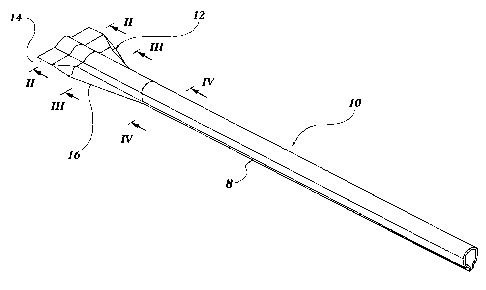Some of the information on this Web page has been provided by external sources. The Government of Canada is not responsible for the accuracy, reliability or currency of the information supplied by external sources. Users wishing to rely upon this information should consult directly with the source of the information. Content provided by external sources is not subject to official languages, privacy and accessibility requirements.
Any discrepancies in the text and image of the Claims and Abstract are due to differing posting times. Text of the Claims and Abstract are posted:
| (12) Patent: | (11) CA 2414540 |
|---|---|
| (54) English Title: | REINFORCING ROD FOR BODY AND/OR CHASSIS ELEMENT OF A MOTOR VEHICLE |
| (54) French Title: | BARRE DE RENFORT POUR ELEMENT DE CARROSSERIE ET/OU DE CHASSIS D'UN VEHICULE AUTOMOBILE |
| Status: | Expired and beyond the Period of Reversal |
| (51) International Patent Classification (IPC): |
|
|---|---|
| (72) Inventors : |
|
| (73) Owners : |
|
| (71) Applicants : |
|
| (74) Agent: | MACRAE & CO. |
| (74) Associate agent: | |
| (45) Issued: | 2008-09-09 |
| (86) PCT Filing Date: | 2000-11-30 |
| (87) Open to Public Inspection: | 2001-12-06 |
| Examination requested: | 2005-11-07 |
| Availability of licence: | N/A |
| Dedicated to the Public: | N/A |
| (25) Language of filing: | English |
| Patent Cooperation Treaty (PCT): | Yes |
|---|---|
| (86) PCT Filing Number: | PCT/IB2000/001772 |
| (87) International Publication Number: | WO 2001092042 |
| (85) National Entry: | 2002-12-23 |
| (30) Application Priority Data: | |||||||||
|---|---|---|---|---|---|---|---|---|---|
|
A reinforcing bar for body and/or chassis parts of a motor vehicle includes a
one-piece element (8) extending from one end of the bar to the other and
having a median portion (10) with a closed tubular cross section and at least
one end portion (12) comprising an open-section distal portion (14) and a
proximal portion (16) which connects the said distal portion (14) to the
median portion (10).
La présente invention concerne une barre de renfort destinée à des parties de carrosserie et/ou de châssis d'un véhicule automobile, ladite barre comprenant un élément monobloc (8) s'étendant d'une extrémité de la barre à l'autre, et présentant une partie médiane (10) ayant une section transversale tubulaire fermée, et au moins une partie terminale (12) comprenant une partie distale à section ouverte (14) et une partie proximale (16) qui relie ladite partie distale (14) à la partie médiane (10).
Note: Claims are shown in the official language in which they were submitted.
Note: Descriptions are shown in the official language in which they were submitted.

2024-08-01:As part of the Next Generation Patents (NGP) transition, the Canadian Patents Database (CPD) now contains a more detailed Event History, which replicates the Event Log of our new back-office solution.
Please note that "Inactive:" events refers to events no longer in use in our new back-office solution.
For a clearer understanding of the status of the application/patent presented on this page, the site Disclaimer , as well as the definitions for Patent , Event History , Maintenance Fee and Payment History should be consulted.
| Description | Date |
|---|---|
| Time Limit for Reversal Expired | 2010-11-30 |
| Letter Sent | 2009-11-30 |
| Grant by Issuance | 2008-09-09 |
| Inactive: Cover page published | 2008-09-08 |
| Inactive: Final fee received | 2008-06-25 |
| Pre-grant | 2008-06-25 |
| Notice of Allowance is Issued | 2008-02-04 |
| Letter Sent | 2008-02-04 |
| Notice of Allowance is Issued | 2008-02-04 |
| Inactive: Approved for allowance (AFA) | 2007-11-16 |
| Amendment Received - Voluntary Amendment | 2007-10-11 |
| Inactive: S.30(2) Rules - Examiner requisition | 2007-06-08 |
| Letter Sent | 2005-11-16 |
| Request for Examination Requirements Determined Compliant | 2005-11-07 |
| All Requirements for Examination Determined Compliant | 2005-11-07 |
| Request for Examination Received | 2005-11-07 |
| Inactive: Office letter | 2004-08-17 |
| Inactive: Multiple transfers | 2004-07-22 |
| Inactive: Cover page published | 2003-03-04 |
| Inactive: Applicant deleted | 2003-02-28 |
| Inactive: Notice - National entry - No RFE | 2003-02-28 |
| Application Received - PCT | 2003-02-03 |
| National Entry Requirements Determined Compliant | 2002-12-23 |
| Application Published (Open to Public Inspection) | 2001-12-06 |
There is no abandonment history.
The last payment was received on 2007-09-28
Note : If the full payment has not been received on or before the date indicated, a further fee may be required which may be one of the following
Please refer to the CIPO Patent Fees web page to see all current fee amounts.
| Fee Type | Anniversary Year | Due Date | Paid Date |
|---|---|---|---|
| MF (application, 2nd anniv.) - standard | 02 | 2002-12-02 | 2002-12-23 |
| Reinstatement (national entry) | 2002-12-23 | ||
| Basic national fee - standard | 2002-12-23 | ||
| MF (application, 3rd anniv.) - standard | 03 | 2003-12-01 | 2003-10-17 |
| Registration of a document | 2004-07-22 | ||
| MF (application, 4th anniv.) - standard | 04 | 2004-11-30 | 2004-09-28 |
| MF (application, 5th anniv.) - standard | 05 | 2005-11-30 | 2005-09-28 |
| Request for examination - standard | 2005-11-07 | ||
| MF (application, 6th anniv.) - standard | 06 | 2006-11-30 | 2006-09-26 |
| MF (application, 7th anniv.) - standard | 07 | 2007-11-30 | 2007-09-28 |
| Final fee - standard | 2008-06-25 | ||
| MF (patent, 8th anniv.) - standard | 2008-12-01 | 2008-09-30 |
Note: Records showing the ownership history in alphabetical order.
| Current Owners on Record |
|---|
| E.M.A.R.C. S.P.A.-ENGINEERING MACCHINE ATTREZZATURE RAPPRESENTANZE CONSULENZE |
| Past Owners on Record |
|---|
| PIETRO PASSONE |